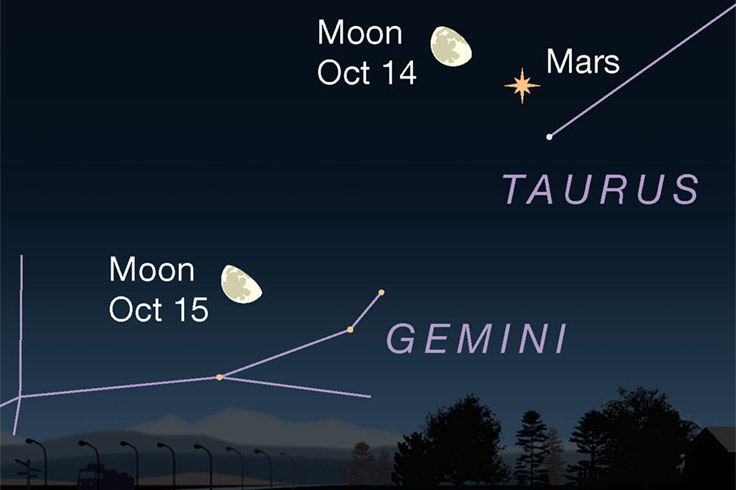Sunday, October 16The waxing gibbous Moon makes a great early-morning target for a telescope today, as several round, prominent craters sit along the terminator near the north lunar pole.
Look first for Aristoteles, with its prominent rim and floor now mostly in shadow. To its west is the Alpine Valley (Vallis Alpes), a straight scar cutting right through the Montes Alpes mountain range. Bump up the magnification as much as possible and look for the rille, or narrow groove, running through Vallis Alpes’ center.
Nearby (farther west) is Plato, a shallow crater set into rougher terrain. With the steepening Sun angle, Plato and its surroundings appear well lit, while Aristoteles is largely dark. Spreading out below Plato is the large basin of Mare Imbrium, bounded on the bottom by bright, ejecta-wreathed Copernicus.

Sunrise: 7:12 A.M.Sunset: 6:19 P.M.Moonrise: 10:57 P.M.
Moonset: 2:00 P.M.Moon Phase: Waning gibbous (60%)
Monday, October 17The Moon reaches apogee, the farthest point from Earth in its orbit, at 6:20 A.M. EDT. At that time, our satellite will sit 251,238 miles (404,328 kilometers) away. A few hours later, our satellite reaches its Last Quarter phase at 1:15 P.M. EDT.
In the several hours before dawn, let’s look to Taurus the Bull, where a cosmic meetup is underway. Mighty Mars is just over 1° north of M1, famously known as the Crab Nebula.
Although the Moon is nearby, zoom in on magnitude –0.9 Mars with a telescope and look for a soft, fuzzy glow nearby. That’s the Crab Nebula, the blown-out guts of a massive star whose supernova was seen from Earth in the year A.D. 1054. Nestled within the nebula now lies a pulsar, a fast-rotating neutron star whose radio “blips” we receive here on Earth at regular intervals.
Through your scope, Mars should appear a decent 14″across and 90 percent lit. It’s still growing in apparent size, approaching its early December opposition. The nebulous Crab sprawls across much more of the sky, stretching 6′ by 4′ in total, though with the Moon nearby you may not see it at quite this size.
Although Mars will continue moving over the next few days, pulling away from M1, so will the Moon. You can return to this region to enjoy M1 all on its own, later this week, likely with a smaller aperture or even binoculars once you’ve got a fully dark sky to work with.

Sunrise: 7:13 A.M.Sunset: 6:17 P.M.Moonrise: 11:55 P.M.Moonset: 2:44 P.M.Moon Phase: Last Quarter
Tuesday, October 18Asteroid 3 Juno stands stationary against the background stars of Aquarius at 8 P.M. EDT tonight. At that time, you’ll find the constellation some 35° high in the south, perfect for evening observing.
Although it was the third asteroid discovered, Juno is 10th largest in the main belt, about 145 miles (234 km) across. The asteroid is currently magnitude 8.4, well within the reach of binoculars and small scopes alike. You’ll find it 2.3° east-southeast of 5th-magnitude Sigma (σ) Aquarii. Together with Sigma as the western anchor point, Juno forms the point of a skewed, upside-down triangle with 4th-magnitude Hydor (Lambda Aquarii) as the eastern point of the triangle’s broad base.
Aquarius sits between the two constellations housing the solar system’s gas giants right now: Magnitude –2.9 Jupiter is east in Pisces, while fainter magnitude 0.5 Saturn lies to the west in Capricornus.

Sunrise: 7:14 A.M.Sunset: 6:16 P.M.
Moonrise: —Moonset: 3:22 P.M.Moon Phase: Waning crescent (41%)
Wednesday, October 19With no Moon in the nighttime sky, let’s look all the way to the Outer Limits — the Outer Limits Galaxy, that is. Cataloged as NGC 891 and also sometimes called the Silver Sliver Galaxy, this 10th-magnitude edge-on spiral sits in Andromeda the Princess, which is 40° high in the northeast around 9 P.M. tonight. Finding the galaxy is relatively easy, too — it is just 3.5° east of 2nd-magnitude Almach (Gamma Andromedae). It should appear easily in even a small scope if your local light pollution is low.
If you’ve got good seeing and a large aperture, look closely for the dust lane that bisects the galaxy right down the middle. Look also at its shape — NGC 891 is about 4 times as long as it is wide. How much of its extended glow can you see?
Why is it called the Outer Limits Galaxy? The answer is simple: An image of this target appeared in the end credits of the The Outer Limits television show, along with seven additional objects. Astronomy contributing editor Michael E. Bakich takes you on a tour of all of them in his 2019 article “The Outer Limits universe.”

Sunrise: 7:15 A.M.Sunset: 6:14 P.M.Moonrise: 12:57 A.M.Moonset: 3:53 P.M.Moon Phase: Waning crescent (32%)
Thursday, October 20Now that Comet C/2017 K2 PanSTARRS has left the Northern Hemisphere’s celestial stage, it’s time to begin honing in on our next cometary target: Comet C/2022 E3 (ZTF). Predicted to possibly reach naked-eye visibility in early 2023, for now the magnitude 11 comet remains in the realm of medium to large amateur scopes. It’s currently floating near Coma Berenices and is visible for several hours in the west after sunset.
No evening Moon means darker skies and better chances of catching this cosmic puffball. Opt for a viewing location with little to no ground light if possible and point your scope toward the horseshoe-shaped Northern Crown. Tonight, ZTF sits just 0.5° south-southeast of magnitude 4.6 Delta (δ) Coronae Borealis.
The comet is still some 2.2 astronomical units from Earth, where 1 astronomical unit, or AU, is the average Earth-Sun distance. It is now 1.7 AU from the Sun and will reach perihelion in the first half of January next year — hence its expected brightness in a few months.

Sunrise: 7:16 A.M.
Sunset: 6:13 P.M.Moonrise: 2:00 A.M.Moonset: 4:20 P.M.Moon Phase: Waning crescent (23%)





